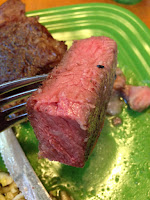Once you jar it, depending on the ambient temperature of your house, you may have to microwave it for about 20-30 seconds and stir before applying it to whatever. It's been in the lower 60s in our house, and it's quite solid in the jar. Now, when it was 80 degrees, the stuff flowed...right into my face and right into my belly! Nom, nom, nom...
Homemade Chocolate Hazelnut Spread
(Makes 2 Cups)
1 cup raw hazelnuts; this can be heaping as they will shrink a bit while toasting
12 ounces milk chocolate, chopped; can use a bag of milk chocolate chips like Giradelli (one standard 11.5 oz. bag works, the half ounce isn't going to throw off the recipe)
2 Tbls. canola oil
3 Tbls. confectioner's sugar
1 Tbls. unsweetened cocoa
1/2 tsp. vanilla extract
3/4 tsp. Kosher salt; more or less depending on your taste, but I think this amount is perfect
Preheat your oven to 350°F.
 |
| I use my counter-top toaster oven. |
 Spread hazelnuts in a single layer on a baking sheet and toast in the
heated oven. Check every 5 minutes and give the pan a shake to move
them around. They will become slightly browned and the skins will
blister. Be careful not to burn them! Take them from the oven.
Spread hazelnuts in a single layer on a baking sheet and toast in the
heated oven. Check every 5 minutes and give the pan a shake to move
them around. They will become slightly browned and the skins will
blister. Be careful not to burn them! Take them from the oven.I roasted some pretty dark and it made the finished spread have more of a deeper, almost coffee-like flavor. I didn't mind this, but it I think burnt ones would be terrible.
Wrap the nuts in a clean kitchen towel (or a large clean cloth napkin like I did) and rub vigorously to remove most of the skins. It's okay if some still stick. Okay, I admit that I have OCD and I sorted through the nuts by hand and peeled off as much of the skins as I could, but you don't have to be that picky if you're not compelled to be so. Let the nuts completely cool.


 In a food processor, grind the hazel nuts until fine. Then add the oil,
sugar, vanilla, cocoa powder and salt and continue to process until the
nuts have become a paste. This make take some time and you may have to
scrape down the bowl. The more you grind the better to alleviate any
unpleasant grittiness. Unless you like that!
In a food processor, grind the hazel nuts until fine. Then add the oil,
sugar, vanilla, cocoa powder and salt and continue to process until the
nuts have become a paste. This make take some time and you may have to
scrape down the bowl. The more you grind the better to alleviate any
unpleasant grittiness. Unless you like that!Melt the chocolate in the microwave. I set the timer for 1 minute and 20 seconds and stopped it every 20 second intervals and stirred in between. Microwave until chocolate is mostly melted. It's best to still see pieces and stir until all has melted. The residual heat will melt the chocolate nicely and it will be cool enough to add now.
Add the chocolate into your nut paste and process until very smooth. It won't be perfectly smooth like the commercial kind, but I like it and it's not as pasty
The mixture will be very runny, but will thicken a bit when cooled completely. Pour into re-sealable jars (1 pint jars work great) or two ½ pint jars if you want to give one to a friend, but who wants to do that??
This will keep on your counter for up to 2 weeks...that is if it will last that long.
I love this slathered onto warm toast, graham crackers, and my tongue!









































